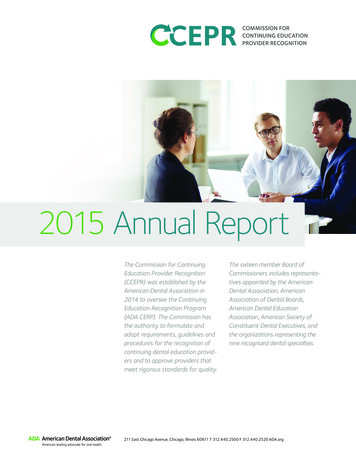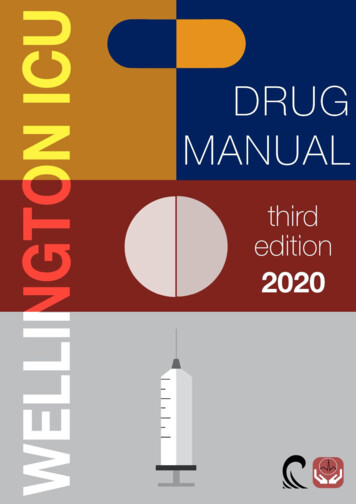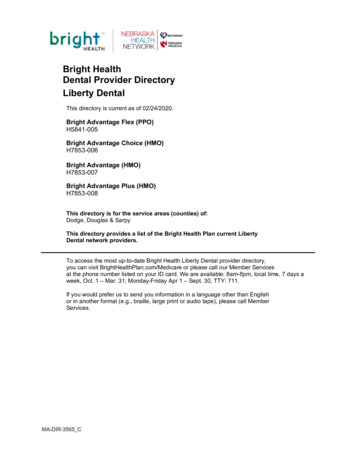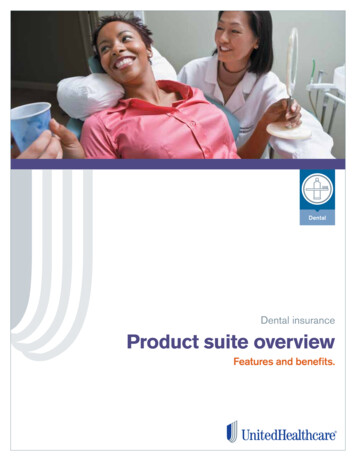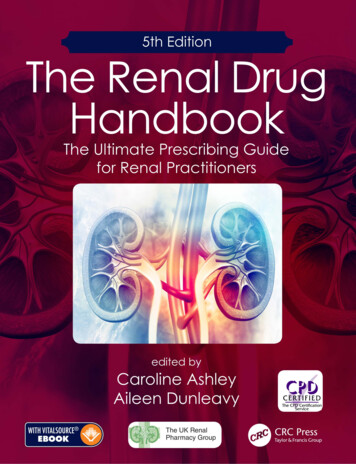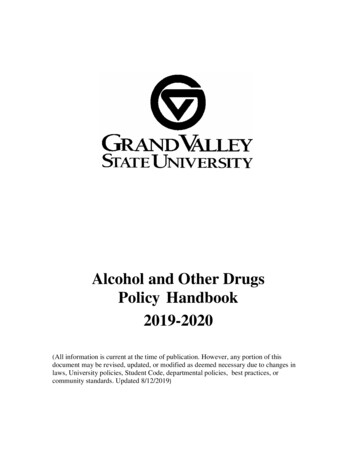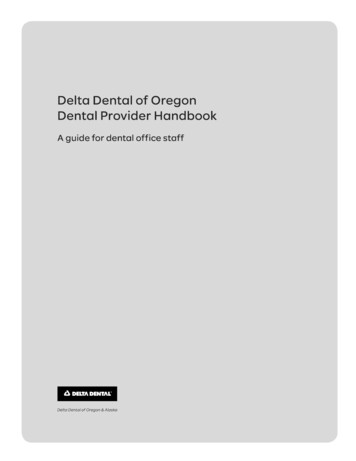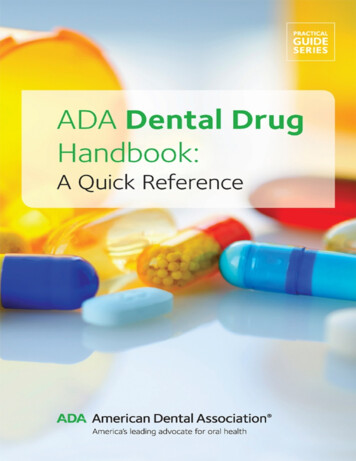
Transcription
AcknowledgementsThe American Dental Association’s Science Institute and the Department of Product Developmentand Sales developed this publication following a request by the ADA New Dentist Committee in2015.Principal contributions to this manuscript were made by Jay Elkareh, Pharm.D., Ph.D, Manager,Product Evaluation, Science Institute; Anita Mark, Senior Scientific Content Specialist, ADAScience Institute; Kathy Pulkrabek, Manager/Editor, Professional Products, Department ofProduct Development and Sales; and Carolyn Tatar, MBA, Senior Manager, Product Developmentand Sales at the American Dental Association.External contributions to this manuscript were made by The ADA Dental Drug Handbook EditorialAdvisory Panel: Sebastian Ciancio, DDS, MS, Director, Center for Clinical Dental Studies, andAdjunct Professor of Pharmacology, University at Buffalo School of Dental Medicine; Paul Eleazer,DDS, MS, Professor and Chair, Department of Endodontics, University of Alabama School ofDentistry; and Paul A. Moore, DMD, PhD, MPH, Professor, Pharmacology, Dental Anesthesiologyand Dental Public Health, University of Pittsburgh School of Dental Medicine.This book was designed by Lisa Empleo of Gray Cat Graphic Design.
2019 American Dental Association. All rights reserved. No part of this publication may bereproduced or transmitted, in any form or by any means, electronic or mechanical, includingphotocopying, recording, information storage and retrieval system, or otherwise, without the priorwritten permission of the American Dental Association. American Dental Association is aregistered trademark.
The American Dental Association (ADA), the authors and editors (together the “Publishers”)publish and present the ADA Dental Drug Handbook to you. This handbook does not constitutepolicy of the ADA, establish a standard of care or restrict a dentist’s exercise of professionaljudgment. As the science of dental therapeutics evolves, changes in drug treatment and usebecome necessary. The reader is advised to consult the package insert for each drug to considerand adopt all safety precautions, before use, particularly with new and infrequently used drugs.The reader is responsible for ascertaining the U.S. Food and Drug Administration clearance ofeach drug and device used in his or her practice. Many of the proprietary names of the productslisted in this book are trademarked and registered in the U.S. Patent Office. It should beunderstood that by making this material available, the Publishers are not advocating the use ofany product described herein, nor are the Publishers responsible for misuse of a product due totypographical error. Additional information on any product may be obtained from the manufacturer.Most of the chapters in the handbook will include drug monographs. These monographs give abroad pharmacological overview of the many drugs used in dentistry (e.g., drug interactions,adverse drug reactions, pharmacokinetics, contraindications, etc.). The clinical information hasbeen compiled from various sources such as the U.S. Food & Drug Administration (www.fda.gov),Epocrates (www.epocrates.com), Lexicomp (online.lexi.com), Medscape (www.medscape.com).For a comprehensive drug profile, please refer to the previously mentioned websites or see thedrug package insert.Most of the monographs include a sample prescription. Clinicians are responsible to adjust theprescription dose, frequency and length of treatment based on the procedure performed, themedicine prescribed, and the patient condition, such as age, weight, metabolism, liver and renalfunction. The sample prescription in the handbook represents only a general recommendation bythe authors based on scientific literature, and expert insights.The Publishers have produced this handbook in their individual capacities and not on behalf or inthe interest of any pharmaceutical companies or state or federal agencies. This handbook doesnot provide legal advice, and readers must consult with their own attorneys for such advice. ThePublishers disclaim all responsibility for any liability, loss, injury or damage resulting directly orindirectly from the reader’s use and application of the information in this book and make norepresentations or warranties with respect to such information, including the products describedherein.
Table of ContentsSection 1: Drugs Used in DentistryChapter 1. Analgesics and Acute Pain Management Dr. Kathleen ZieglerChapter 2. Antibiotics Dr. Jay ElkarehChapter 3. Antifungals Dr. S. Craig RhodesChapter 4. Antivirals and Vaccines Dr. Paul EleazerChapter 5. Anxiolytics Dr. Elias Mikael ChatahChapter 6. Fluorides (Topical and Systemic) Dr. Kathleen ZieglerChapter 7. Local Anesthetics for Dentistry Drs. Paul A. Moore and Elliot V.HershChapter 8. Oral Lesions and Corticosteroids Dr. Elias Mikael ChatahChapter 9. Salivary Management Dr. Jay ElkarehChapter 10. Smoking Cessation Dr. Kathleen ZieglerChapter 11. Supplemental Drugs: Allergy Management, Herbals inDental Health, Skeletal Muscle Relaxants Drs. Lakshmanan Suresh and LidaRadfarChapter 12. OTC Products with the ADA Seal of Acceptance Mr. LouisErazoSection 2: Pediatric Drug ManagementDrs. Martha Ann Keels and Erica BrecherSection 3: Emergency Drug ManagementDr. Jay Elkareh
Section 4: Special Care PatientsDr. Kathleen Ziegler Guidelines in Specific Procedures Guidance in Specific PopulationsSection 5: Useful TablesDr. Jay Elkareh Adverse Drug Reactions (Oral) Drug-Drug Interactions Generic Brand List
ContributorsErica Brecher, DMD, MSAssistant Professor, Department of Pediatric DentistryVirginia Commonwealth University School of DentistryRichmond, VirginiaElias Mikael Chatah, DMD, B. Pharm, MSAssistant Clinical ProfessorGroup Practice LeaderUniversity of Connecticut School of Dental MedicineFarmington, ConnecticutSebastian Ciancio, DDS, MSDistinguished Service Professor and ChairDepartment of Periodontics & EndodonticsAdjunct Professor of PharmacologyDirector, Center for Clinical Dental StudiesUniversity at Buffalo School of Dental MedicineBuffalo, New YorkPaul Eleazer, DDS, MSProfessor and Chair, Department of EndodonticsUniversity of Alabama School of DentistryBirmingham, AlabamaJay Elkareh, PharmD, PhDManager, Product EvaluationScience InstituteAmerican Dental AssociationChicago, IllinoisLouis Erazo, BSClinical Research Associate, Acceptance ProgramScience InstituteAmerican Dental AssociationChicago, IllinoisElliot V. Hersh, DMD, MS, PhDProfessor, Oral Surgery and PharmacologyDirector, Division of Pharmacology and Clinical TherapeuticsUniversity of Pennsylvania School of Dental MedicinePhiladelphia, PennsylvaniaMartha Ann Keels, DDS, PhDAdjunct Professor in Pediatric DentistryUniversity of North Carolina School of DentistryAssociate Consulting Associate Professor in Surgery
Adjunct Associate Professor in PediatricsDuke UniversityPrivate Practice, Pediatric DentistryDurham, North CarolinaPaul A. Moore, DMD, PhD, MPHProfessor, Pharmacology, DentalAnesthesiology and Dental Public HealthUniversity of Pittsburgh School of DentalMedicinePittsburgh, PennsylvaniaLida Radfar, DDS, MSDiplomat, American Board of Oral MedicineClinical Professor of Oral Medicine, OralDiagnosis and Radiology DepartmentUniversity of Oklahoma College of DentistryOklahoma City, OklahomaS. Craig Rhodes, DMD, MSDAssociate Professor and Director, GraduateEndodonticsCenter for Advanced Dental EducationSaint Louis UniversitySt. Louis, MissouriLakshmanan Suresh, DDS, MS, PhD, D(ABMLI), D(ABOMP)Clinical Professor, Department of Oral Diagnostic SciencesSchool of Dental MedicineState University of New York at BuffaloBuffalo, New YorkKathleen M. Ziegler, PharmDManager, Scientific InformationScience InstituteAmerican Dental AssociationChicago, Illinois
PrefaceThis ADA handbook is designed to serve not only as a clinicaleducational resource but also to promote clinical best practices to alldental professionals. The handbook presents a range of information in aconcise, attractive, easy-to-follow format. It is intended for use bypracticing dentists, students, dental educators and the entire dental teamto assist them in the treatment of patients. The goal was to create anindispensable, “go to” drug reference for dental professionals.Patients are being prescribed more medications today than ever before.Due in part to our aging and mobile population, dentists are confrontedwith many considerations when treating patients. Patients seeking dentalcare are often using a wide range of medications for various medicalproblems. In addition, both dentist and patient have many choices tomake about the variety of products available today for treating disordersof the mouth.In ADA-sponsored focus groups, practicing dentists have expressed aneed for a quick and accurate drug reference developed specifically forthem. This handbook is based on what those dentists told us they needto make their practices complete: concise and accurate information aboutthe medications they use. They wanted information that was based onthe best practices of science and pharmacology and organized by drugcategory.The book contains five sections; the main section focuses on drugs usedby the dentist. Each chapter starts with a brief overview of the categoryand contains easy-to-use drug monographs with sample prescriptions,contraindications, precautions, drug interactions, common side effectsand more. Other sections include pediatric management, dental officeemergencies, handling patients with specific medical conditions anduseful tables.A team of dentists, pharmacists, scientists, and experts in pharmacologyhave worked together to create a unique, complete, and easy-to-read
therapeutics publication for dental profession and beyond.Jay Elkareh, Pharm.D., Ph.D.EditorManager, Product EvaluationScience InstituteAmerican Dental Association
Section1Drugs Used in Dentistry
Chapter 1:Analgesics and Acute PainManagementKathleen Ziegler, PharmDOverviewPain management is an integral part of dental practice. There are twomain types of pain: nociceptive, which is treated with nonopioid andopioid analgesics; or neuropathic, which is treated with adjunctive agentssuch as anticonvulsant and antidepressant medications. This chapter willfocus on oral nonopioid and opioid analgesics. These conventionalanalgesics either interrupt ascending nociceptive impulses or depresstheir communication within the central nervous system.Depending on the dental intervention performed, acute postproceduralpain can be anticipated to be mild, moderate, or severe (Table 1).In 2016, the ADA House of Delegates adopted a statement on the use ofopioids in the treatment of dental pain, which stated, “Dentists shouldconsider nonsteroidal anti-inflammatory analgesics as the first-linetherapy for acute pain management.”Table 1. Anticipated postprocedural pain according to dental ine endodonticsAnticipated PostproceduralPain
Scaling/root planingMildSimple extractionSubgingival restorative proceduresImplant surgeryQuadrant periodontal flap surgery with bonyrecontouringModerateSurgical endodonticsSurgical extractionComplex implantPartial or full bony impaction surgerySeverePeriodontal surgery1 Strategy for Dental Pain ManagementIf pain is anticipated to last 24 to 48 hours following the procedure,patients are advised to take the prescribed medication on a regularlyscheduled basis for the 1st two days to prevent pain recurrence whenplasma drug levels fall off between doses. The remainder of themedication can be taken “as needed” (i.e., prn) for breakthrough pain.One algorithm for management of various levels of dental pain wasdeveloped by Moore and Hersh. Using the anticipated pain level followinga dental procedure, they recommended a stepwise management plan(Table 2).Other therapeutic strategies include administration of NSAIDs 1 hourprior to the procedure and use of longer-acting local anesthetics (e.g.,bupivacaine 0.5% with 1:200,000 epinephrine) during the immediatepostoperative period. Also, perioperative administration of acorticosteroid (e.g., dexamethasone) may limit inflammation anddecrease pain following third-molar extractions (See Chapter 8: OralLesions and Corticosteroids).Table 2. Analgesic Use According to Pain LevelAnticipatedAnalgesic Recommendation
Pain LevelMildSingle-agent ibuprofen 200 to 400 mg as neededSingle-agent ibuprofen 400 to 600 mg fixed interval every 6 hoursfor 24 hoursMild toModeratethenSingle-agent ibuprofen 400 mg as needed for pain every 4 to 6hoursIbuprofen 400 to 600 mg plus acetaminophen 500 mg fixedinterval every 6 hours for 24 hoursModerateto SeverethenIbuprofen 400 mg plus acetaminophen 500 mg as needed for painevery 6 hoursIbuprofen 400 to 600 mg plus acetaminophen 650 mg withhydrocodone 10 mg fixed interval every 6 hours for 24 to 48 hoursSeverethenIbuprofen 400 to 600 mg plus acetaminophen 500 mg as neededfor pain every 6 hoursAdapted from: Moore PA, Hersh EV. Combining ibuprofen and acetaminophen for acute painmanagement after third-molar extractions: translating clinical research to dental practice. J AmDent Assoc 2013;144(8):898-908.2 Nonopioid AnalgesicsThe nonopioid analgesics include acetaminophen, aspirin and otherNSAIDs. The maximum analgesic effect of acetaminophen or aspirinusually occurs with single doses between 650 and 1300 mg. For NSAIDsother than aspirin, the analgesic ceiling may be somewhat higher. Oneadvantage is that tolerance does not develop to the analgesic effects ofthese drugs.The anti-inflammatory and analgesic properties of NSAIDs, as well asmost of their adverse effects, result from their inhibition ofcyclooxygenase (COX), which is a key enzyme in the production ofpostoperative pain and inflammation due to its ability to convertarachidonic acid to prostaglandins. Prostaglandins are mediators ofinflammation, fever, and pain. Aspirin inactivates COX by irreversible
acetylation, whereas the newer NSAIDs are reversible competitiveinhibitors of COX. Most NSAIDs bind weakly and reversibly to plateletCOX, interfering with platelet aggregation only until the drug is clearedfrom the system; however, because aspirin irreversibly binds plateletCOX, platelet function is permanently affected for the life of the platelet (8to 10 days). Prostaglandins also have a role in GI mucosal protection andplay an essential role in renal perfusion; this accounts for the potential ofNSAIDs to cause gastrointestinal complications (i.e., bleeding) andnephrotoxicity, respectively.The mechanism of action of acetaminophen is less clear compared withNSAIDs; however, it is thought to involve inhibition of prostaglandinsynthesis within the central nervous system.3 Opioid AnalgesicsOpioid analgesics can be categorized as full agonists, partial agonists, ormixed agonist/antagonists. Full agonists are generally used for treatmentof moderate-to-severe acute or chronic pain. Unlike NSAIDs, mostopioids have no ceiling for their analgesic effectiveness, except thatimposed by development of adverse effects.The precise mechanism of the analgesic action of opioids is unknown.However, specific central nervous system opioid receptors forendogenous compounds with opioid-like activity have been identifiedthroughout the brain and spinal cord and are thought to play a role in theanalgesic effects of these drugs.Risks of these drugs include nausea and vomiting, drowsiness,respiratory depression, potential addiction, abuse, and misuse. Suggested Reading American Dental Association. Statement on the Use of Opioids in theTreatment of Dental Pain. 2016. tement-on-opioids. Accessed August 3, 2018.Becker DE. Pain management: Part 1: Managing acute andpostoperative dental pain. Anesth Prog 2010;57(2):67-78.
Ganzberg S, Fricton J. Analgesics: Opioids and Nonopioids. In:ADA/PDR Guide to Dental Therapeutics, Ciancio SG, editor. 5th ed.Chicago: American Dental Association and Physician’s DeskReference, Inc., pp 63-133, 2009.Hersh EV, Kane WT, O’Neil MG, et al. Prescribing recommendationsfor the treatment of acute pain in dentistry. Compend Contin EducDent 2011;32(3):22, 24-30.Moore PA, Hersh EV. Combining ibuprofen and acetaminophen foracute pain management after third-molar extractions: translatingclinical research to dental practice. J Am Dent Assoc2013;144(8):898-908.Drugs for pain. Treat Guidel Med Lett 2013;11(128):31-42.Drug MonographThe following table lists some of the opioids and non-opioids analgesicscommonly used in dentistry. The monographs below highlight a 4 daysprescription, however, prescribers are encouraged to use their clinicaljudgment; the length of treatment might vary depending on the procedureperformed and the patient’s anticipated level of pain.NOTE: The sample prescriptions in this handbook represent a generalrecommendation. Clinicians are responsible to adjust the prescriptiondose, frequency and length of treatment based on the procedureperformed, the medicine prescribed, and the patient conditions such asage, weight, metabolism, liver and renal function.Non-Opioids list:
AcetaminophenTablets: 325 mg, 500 mg, 650 mg · Chewable tablets: 80 mg, 160 mgLiquid: 32 mg/mL, 100 mg/mL Dental pain management Take 2 tablets (2x 325 mg) every 6 hours for 4 days as needed(32 tablets) maximum dose 4,000 mg/day manufacturersrecommend 3,000 mg/dayBLACK BOX WARNING – Hepatotoxicity: Acetaminophen has beenassociated with cases of acute liver failure, at times resulting in livertransplant and death especially at doses that exceed 4,000 mg per day,and often involving more than one acetaminophen-containing product. Active and severe hepatic disease Hypersensitivity to acetaminophen Severe hepatic impairment Recent alcohol consumption increases risk of hepatic injury Concurrent use of acetaminophen and isoniazid may result in anincreased risk of hepatotoxicity Concurrent use of acetaminophen and imatinib may result inincreased acetaminophen levels Concurrent use of acetaminophen and warfarin may result in anincreased risk of bleedingCommonReactions: Pruritus Constipation,nausea,vomiting Headache,Less common reactions: Generalized, acute exanthematous pustulosis,Stevens-Johnson syndrome, toxic epidermalnecrolysis Liver failure Pneumonitis
insomnia Agitation Atelectasis Pregnancy Category C Lactation: amounts of acetaminophen secreted in milk are muchless than doses usually given to infants Elderly patients: no specific dosage adjustment is necessary Renal failure: severe renal impairment (CrCl of 30 mL/min or less)increases risk of hepatic injury; dose reductions may be required Hepatic disease: active hepatic disease or hepatic impairmentincreases risk of hepatic injury; dose reductions may be required Recommend patient to keep hydrated and well-nourished while onmedication to avoid hepatic injury Peak serum time: 0.5 to 1 hr Half-life: 2 to 3 hours (adults) Extensively metabolized in the liver Excretion: less than 5% excreted unchanged in urine
AspirinTablets: 81 mg, 325 mg, 500 mg, 650 mg Dental pain management Take 1 to 2 tablets (325 mg to 650 mg) every 4 to 6 hours for 4days as needed (16-48 tablets)maximum dose 4,000 mg/day Hypersensitivity to NSAIDs including aspirin · Syndrome of asthma,rhinitis, and nasal polyps; severe urticaria, angioedema, orbronchospasm Patient with active peptic ulcer disease. Patient with severe hepatic insufficiency Patient with severe renal failure (GFR 10mL/min) · Avoid prior to and following surgery The following medications the risk of bleeding when used with thedrug:– Warfarin, and other anticoagulants– SSRIs such as fluoxetine, citalopram, sertraline– SNRIs such as venlafaxine, duloxetine This drug the effect of diuretics, ACE inhibitors, angiotensinreceptor blockers (ARB), or beta-blockers This drug the concentration and toxicity of methotrexateCommon reactions: HemorrhageLess commonreactions: Gastrointestinal ulcer Exudative age-related macular degenerationReye’ssyndrome Tinnitus Angioedema Bronchospasm Pregnancy: avoid use during third trimester. If used in the first andsecond trimester, it should be used at the lowest dose for the
shortest duration possible Lactation: aspirin is excreted in human milk in small amounts,benefit should outweigh risk Pediatric: not recommended for children 18 years old with historyof chickenpox, flu, or recently received a vaccine Elderly patients: avoid chronic use of doses greater than 325 mgper day recommend patient to take a gastroprotective agent (i.e.,proton pump inhibitor or misoprostol) Alcohol warning: if 3 or more alcoholic beverages are consumedevery day, GI bleeding can occur Peak serum time: 1 hr Half-life: 20 to 60 minute Excretion: 90% as metabolites in urine
CelecoxibTablets: 50 mg, 100 mg, 200 mg, 400 mg Chronic pain management Take 2 tablets (2x 200 mg) to start then 1 tablet (200 mg) every 12hours for 4 days as needed (9 tablets)BLACK BOX WARNING – Cardiovascular thrombotic events such asmyocardial infarction and stroke. Gastrointestinal risk such as bleeding,ulceration, and perforation of the stomach or intestines. Known hypersensitivity to celecoxib, or sulfonamides History of asthma, urticaria, or major skin reactions after takingaspirin or other NSAIDs Patient undergoing a coronary artery bypass graft (CABG) surgery Hepatotoxicity: discontinue if abnormal liver tests persist orworsen or if clinical signs and symptoms of liver disease develop. Hypertension: monitor blood pressure Heart failure and edema patients Renal toxicity: monitor renal function in patients with renalimpairment, heart failure, dehydration, or hypovolemia Avoid use in pregnant women starting at 30 weeks of gestation Hematologic toxicity: monitor hemoglobin or hematocrit in patientswith any signs or symptoms of anemia This drug the effect of the following:– Antihypertensive diuretics such as furosemide and thiazides– Antihypertensive ACE inhibitors such as Lisinopril, andcaptopril– Effect on platelets, including low dose aspirin The following medications the adverse side effects of the drug:– Anticoagulants and antiplatelet such as warfarin, and aspirin– Antidepressant SSRIs such as fluoxetine, sertraline, citalopram– Antiarrhythmic drugs such as digoxin
Common reactions: Abdominal pain, diarrhea, dyspepsia,flatulenceLess commonreactions: Hypertension Peripheral edema, rash Headache Dizziness Insomnia Pharyngitis, Rhinitis, Sinusitis, Upperrespiratory tract infection Pregnancy Category C. Pregnancy Category D from 30 weeks ofgestation onward (because of the risks of premature closure of thefetal ductus arteriosus) Lactation: limited data, caution should be exercised Pediatric: safety and effectiveness in patients younger than theage of 2 years have not been established Elderly patients: start dosing at the low end of the dosing range,and monitor patients for adverse effects Renal impairment: not recommended in patients with severe renalinsufficiency Hepatic impairment reduce dose by 50% in moderately impairedpatients, and avoid in patients with severe hepatic impairment Peak serum time: 3 hours Highly protein bound Half-life: 11 hours Excretion: eliminated predominantly by hepatic metabolism withlittle ( 3%) unchanged drug recovered in the urine and feces
IbuprofenTablets: 100 mg, 200 mg · Chewable tablets: 50 mg, 100 mg Tablets (Rxonly): 400 mg, 600 mg, 800 mg · Liquid: 20 mg/mL, 40 mg/mL Dental pain management Take 1 tablet (600 mg) 3 to 4 times a day for 4 days as needed(12-16 tablets) maximum 2,400 mg/day Take 2 to 3 tablets (2x 200 mg to 3x 200 mg) 4 times a day for 4days as needed (32-48 tablets) maximum 2,400 mg/dayBLACK BOX WARNING – Cardiovascular thrombotic events such asmyocardial infarction and stroke. Gastrointestinal risk such as bleeding,ulceration, and perforation of the stomach or intestines. Hypersensitivity to NSAIDs including aspirin Patients with history of peptic ulcer, or GI bleeding Patient undergoing a coronary artery bypass graft (CABG)surgery. Patients with high blood pressure, heart disease Patients with kidney disease, liver cirrhosis Patients with uncontrolled diabetes, asthma, glaucoma Patients with enlarged prostate, urinary incontinence This drug the effect of the following:– Antihypertensive diuretics such as furosemide and thiazides– Antihypertensive ACE inhibitors such as Lisinopril, andcaptopril– Effect on platelets, including low dose aspirin The following medications the adverse side effects of the drug:– Anticoagulants and antiplatelet such as warfarin, and aspirin– Antidepressant SSRIs such as fluoxetine, sertraline,citalopram
Common reactions: Epigastric pain, heartburn, nausea,vomiting, constipation, diarrhea Skin rash Dizziness, headache, tinnitus Fluid retentionLess commonreactions: Ocularadverseeffects Acute renalfailure Hypertension Depression Hematologiceffects Pregnancy Category C; avoid during late pregnancy Lactation: enters breast milk, compatible with breastfeeding Pediatric: can be used in patients 6 months and older Elderly patients: use with caution due to the higher risk of GIbleeding Avoid in patients with advanced renal disease No dose adjustments in patients with hepatic disease Take with food, dairy products or products containing calcium Peak serum time: 1 to 2 hours More than 99% protein bound Half-life: 1.8 to 2 hours Little is excreted unchanged in urine
NaproxenTablets (OTC): 220 mg (Naproxen Sodium) Tablets: 250 mg, 375 mg, 500mg · Liquid: 25 mg/mL Dental pain management Take 1 tablet (500 mg) 2 times a day for 4 days as needed (8tablets) maximum 1,250 mg/day Take 2 tablets (2x 220 mg) to start then 1 tablet (220 mg) every 8to 12 hours for 4 days as needed (10-14 tablets) maximum 3tablets/dayBLACK BOX WARNING – Cardiovascular thrombotic events such asmyocardial infarction and stroke. Gastrointestinal risk such as bleeding,ulceration, and perforation of the stomach or intestines. Hypersensitivity to NSAIDs or aspirin Patients with history of peptic ulcer, or GI bleeding Patient undergoing a coronary artery bypass graft (CABG)surgery Patients with high blood pressure, heart disease Patients with kidney disease, liver cirrhosis Patients with uncontrolled diabetes, asthma, glaucoma Patients with enlarged prostate, urinary incontinence This drug the effect of the following:– Antihypertensive diuretics such as furosemide and thiazides– Antihypertensive ACE inhibitors such as Lisinopril, andcaptopril– Effect on platelets, including low dose aspirin The following medications the adverse side effects of the drug:– Anticoagulants and antiplatelet such as warfarin, and aspirin– Antidepressant SSRIs such as fluoxetine, sertraline,citalopram
Common reactions: EdemaLess commonreactions: Ecchymosis, pruritus, rash Angioedema Abdominal pain, constipation, heartburn,nausea Acute renalfailure Dizziness, headache, somnolence Hypertension Ototoxicity, tinnitus Bronchospasm Dyspnea Hematologiceffects Pregnancy Category C; avoid during late pregnancy Lactation: enters breast milk, avoid if not necessary Pediatric: safety and effectiveness in patients 2 years old hasnot been established Elderly patients: use with caution and start at lower doses Avoid in patients with moderate to advanced renal disease Take with food, dairy products or products containing calcium Bioavailability of naproxen is unaffected by food or time-of-daydosing Peak serum time (naproxen sodium): 1 to 2 hours Peak serum time (naproxen): 2 to 4 hours Half-life: 12 to 17 hours Excretion: approximately 95% of the naproxen from any dose isexcreted in the urine, primarily as naproxen and metabolitesOpioids:Opioids can be used as single agents or in combination withacetaminophen (APAP), aspirin (ASA), or ibuprofen. Codeine,dihydrocodeine, oxycodone, hyrocodone, hydromorphone, and tramadol.Oxycodone’s monograph is displayed below due to its common use as asingle agent, while hyrocodone and codeine are rarely used as such. Theproperties of most opioids are somehow similar to that of oxycodone, andthe monograph below can be used as a sample monograph. (For more
information about other opioids molecules, please refer to the FDAwebsite at www.accessdata.fda.gov/scripts/cder/daf.)
Oxycodone (Immediate Release)Tablets: 5 mg, 10 mg, 15 mg, 20 mg, 30 mg Liquid: 1 mg/mL, 20 mg/mL Dental pain management Take 1 to 2 tablets (1x 5 mg to 2x 5 mg) every 4 to 6 hours for4 days as needed for pain (16-48 tablets)BLACK BOX WARNINGAddiction, abuse, and misuse: assess each patient’s risk factors andmonitor regularly.Life-threatening respiratory depression: monitor for respiratorydepression, especially during initiation of treatment or following a doseincrease.Accidental ingestion: accidental ingestion of oxycodone especially bychildren, can result in a fatal overdose.Neonatal opioid withdrawal syndrome: prolonged use of oxycodone orhydrocodone during pregnancy can result in neonatal opioid withdrawalsyndrome.Cytochrome P450 3A4 interaction: the concomitant use of oxycodonewith all cytochrome P450 3A4 inhibitors may result in an increase inplasma concentrations. In addition, discontinuation of a concomitantlyused cytochrome P450 3A4 inducer may result in an increase inoxycodone concentration.Risks from concomitant use with benzodiazepines or other CNSdepressants: concomitant use of opioids with benzodiazepines or othercentral nervous system depressants, including alcohol, may result inprofound sedation, respiratory depression, coma, and death. Known hypersensitivity to oxycodone Significant respiratory depression Acute or severe bronchial asthma in an unmonitored setting Known or suspected gastrointestinal obstruction, includingparalytic ileus
Patient with adrenal insufficiency Patient with severe hypotension Hepatotoxicity (when combined with acetaminophe
Most of the chapters in the handbook will include drug monographs. These monographs give a broad pharmacological overview of the many drugs used in dentistry (e.g., drug interactions, adverse drug reactions, pharmacokinetics, contraindicati
